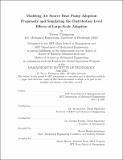Modeling Air Source Heat Pump Adoption Propensity and Simulating the Distribution Level Effects of Large-Scale Adoption
Author(s)
Thompson, Trevor J.
DownloadThesis PDF (3.289Mb)
Advisor
Perakis, Georgia
Leeb, Steven
Terms of use
Metadata
Show full item recordAbstract
National Grid, like most utilities and companies in the energy sector, finds itself at a critical juncture for decarbonization. To maintain alignment with regional carbon reduction goals, it must find innovative ways to reduce greenhouse gas emissions in its service territories. For the heating sector in particular, air source heat pump (ASHP) technology presents a promising avenue for decarbonization – especially for residential customers. ASHPs present the lowest carbon emissions heating option for customers in New England today, and are expected to only become "greener" as the electrical grid continues transitioning to cleaner sources of electricity generation. From a cost perspective, ASHPs are on average the most cost effective space conditioning solution available for new construction. However, for the majority of customers in the Northeast who are retrofitting equipment into an existing home, ASHPs lag behind natural gas as the most cost-effective solution – a trend expected to continue through 2050. Nevertheless, ASHPs present an attractive financial savings opportunity for delivered fuel customers without access to natural gas. To meet its stated Northeast 80x50 Pathway goals, National Grid must increase the rate of ASHP adoption by nearly ten times its current pace. Using Rhode Island and Massachusetts as examples, we demonstrate how the use of machine learning can enable utilities to effectively model the ASHP adoption propensity of each household in their jurisdiction using readily available data. The resulting household-level propensity scores can be employed to guide targeted marketing efforts or aggregated to help guide program design. Additionally, we demonstrate the use of ASHP propensity scores to inform distribution feeder load growth simulations – allowing utilities to more efficiently plan infrastructure upgrades in response to load growth caused by SHP adoption. The same methodology can be applied to better understand the adoption trajectory for any technology relevant to the modern utility.
Date issued
2021-06Department
Massachusetts Institute of Technology. Department of Mechanical Engineering; Sloan School of ManagementPublisher
Massachusetts Institute of Technology